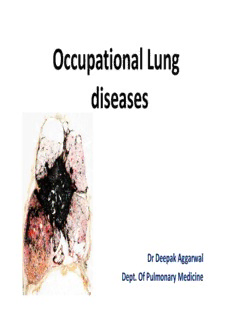
Occupational Lung diseases PDF
Preview Occupational Lung diseases
Occupational Lung diseases Dr Deepak Aggarwal Dept. Of Pulmonary Medicine To be discussed…. • Pneumoconiosis • Hypersensitivity Pneumonitis PNEUMOCONIOSIS Pneumoconioses are pulmonary diseases caused by mineral dust inhalation in workplace The specific types of pneumoconioses are named by the substance inhaled (e.g., silicosis, asbestosis, anthracosis) PNEUMOCONIOSIS Mineral Dust‐Induced Lung Disease Simple coal workers' pneumoconiosis: Coal mining Coal dust macules and nodules Complicated coal workers' pneumoconiosis: PMF Silica Silicosis Sandblasting, quarrying, mining, stone cutting, foundry work, ceramics Asbestosis pleural effusions, pleural plaques, or Mining, milling, Asbestos and fabrication of diffuse fibrosis; mesothelioma; carcinoma of the ores and lung and larynx materials; installation and removal of insulation Fibrogenic pneumoconioses "true pneumoconioses" • asbestosis • berylliosis • talcosis • silicosis • kaolin pneumoconiosis. • hard metal disease • coal workers' • aluminum fibrosis, pneumoconiosis Shaver's disease Non‐fibrogenic pneumoconioses benign pneumoconioses Causes: • antimony • iron • barium • tin • boric acid • titanium • manganese • bismuth PNEUMOCONIOSIS Pathogenesis The development of a pneumoconiosis depends on (1) the amount of dust retained in the lung and airways (2) the size, shape, and buoyancy of the particles (3) solubility and physiochemical reactivity (4) the possible additional effects of other irritants (e.g., concomitant tobacco smoking) PNEUMOCONIOSIS Pathogenesis (1)The amount of dust retained in the lungs is determined by dust concentration in surrounding air duration of exposure effectiveness of clearance mechanisms PNEUMOCONIOSIS Pathogenesis (2) the size, shape, and buoyancy of the particles The most dangerous particles range from 1 to 5 μm in diameter because they may reach the terminal small airways and air sacs and settle in their linings
Description: